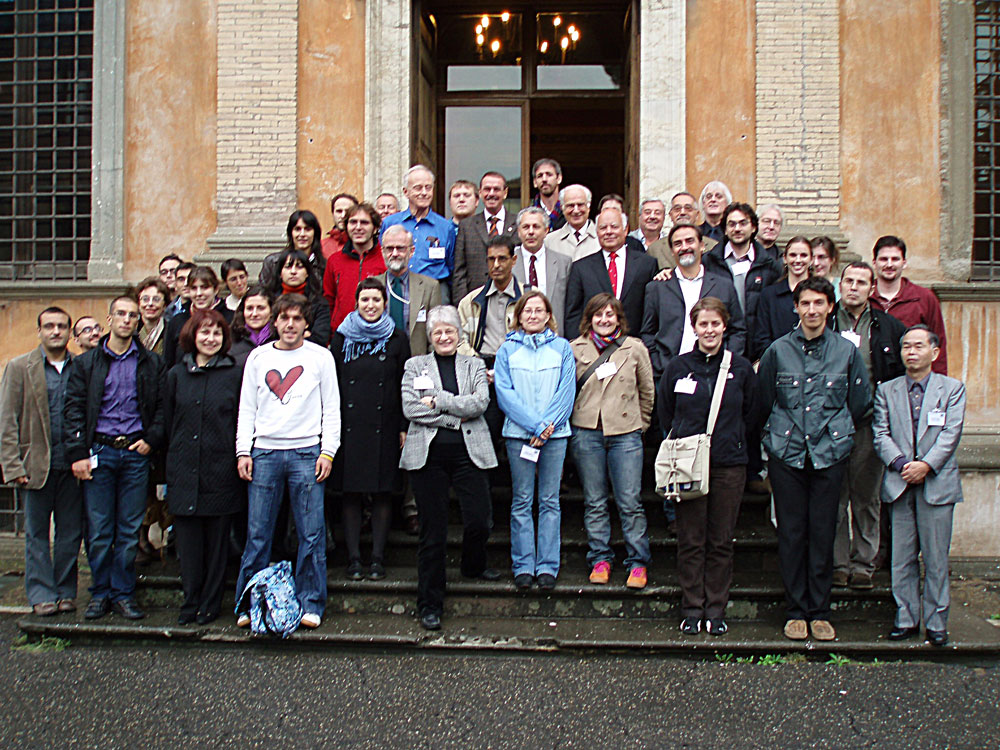Short course, October 29-31, 2007, Rome, Italy
organized by
Giancarlo Della Ventura: dellaven[at]uniroma3.it
Frank C. Hawthorne: frank_hawthorne[at]umanitoba.ca
Annibale Mottana: mottana[at]uniroma3.it
Roberta Oberti: oberti[at]crystal.unipv.it
October 28-31/2007, the Mineralogical Society of America and the Accademia Nazionale dei Lincei (with further financial support from the International Union of Crystallography and the European Mineralogical Union) put on a Short Course on Amphiboles: Crystal Chemistry, Occurrence and Health Issues in Rome, Italy, in the beautiful setting of the Palazzo Corsini, Headquarters of the Accademia Nazionale dei Lincei. The course had 40 participants who listened to lectures covering all aspects of amphiboles from their crystallography to their importance in affecting human health, and received a beautifully produced volume of Reviews in Mineralogy and Geochemistry (Volume 67, 545 pages) covering the topics of the course. The proceedings ran like clockwork, thanks to the staff of the Accademia Nazionale dei Lincei who provided local organizational and logistic support. The course was organized by Giancarlo Della Ventura, Frank Hawthorne, Annibale Mottana and Roberta Oberti, who also edited the accompanying RIMG volume.
The approach taken in this course was somewhat different from that usually taken for mineral groups: the focus was on the properties of amphiboles and the role of amphiboles in geological environments (rather than on experimental techniques), and the results of experimental techniques were integrated into each focus area. The course started with a masterly survey of the history of amphibole studies by Curzio Cipriani. Frank Hawthorne provided a general overview of amphibole crystal chemistry, and Roberta Obertl an examination of issues concerned with amphibole classification and nomenclature. Giancarlo Della Ventura talked about new amphibole compositions that have been discovered or synthesized in the last ten years, a topic that has greatly affected current views on amphibole classification. Roberta Oberti presented a comprehensive survey of long-range order in amphiboles, and was followed by Frank Hawthorne who discussed short-range order and its implications for amphibole stability. Mark Welch and Fernando Càmara gave two presentations on in-situ studies of amphiboles at high temperature and high pressure, focusing in particular on phase transitions. Bernard Evans discussed the synthesis and stability of some end-member amphiboles, and Walter Maresch dealt with the complexities of reaction paths in amphibole synthesis. Bob Martin discussed igneous amphiboles, with a particular emphasis on tectonic environment, and John Schumacher dealt with the composition and coexistence of metamorphic amphiboles. Mickey Gunter and Annibale Mottana dealt with the impact of asbestiform amphiboles on the environment and human health; Mickey discussed techniques used to characterize amphibole particles/fibres, together with some localities where asbestiform amphiboles have impacted society, and Annibale described the distribution of asbestos-related health problems in Italy and their relation to geology and industrial activity. The final dinner was a gustatory delight, and was enlivened by the announcement that three of the lecturers had been honoured by MSA: Bernard Evans is to receive the Roebling Medal, and both Mark Welch and Giancarlo Della Ventura were elected Fellows of MSA.


